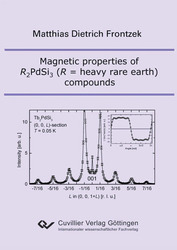| Areas | |
|---|---|
| Serie de libros (96) |
1378
|
| Nachhaltigkeit |
3
|
| Gesundheitswesen |
1
|
| Letra |
2363
|
| Ciencias Naturales |
5406
|
| Matemática | 229 |
| Informática | 319 |
| Física | 980 |
| Química | 1363 |
| Geociencias | 131 |
| Medicina humana | 243 |
| Estomatología | 10 |
| Veterinaria | 108 |
| Farmacia | 147 |
| Biología | 835 |
| Bioquímica, biología molecular, tecnología genética | 121 |
| Biofísica | 25 |
| Nutrición | 45 |
| Agricultura | 1004 |
| Silvicultura | 201 |
| Horticultura | 20 |
| Ecología y conservación de la tierra | 148 |
| Ciencias Ingeniería |
1791
|
| General |
98
|
|
Leitlinien Unfallchirurgie
5. Auflage bestellen |
|
Erweiterte Suche
Magnetic properties of R2PdSi3 (R = heavy rare earth) compounds (Tienda española)
Matthias Dietrich Frontzek (Autor)Previo
Indice, Datei (61 KB)
Lectura de prueba, Datei (470 KB)
The R2PdSi3 (R = heavy rare earth) have been synthesized first in 1990 in the search for materials with unusual electronic properties. The availability of single crystals was the starting point for several investigations of the magneto-crystalline anisotropy, also in applied magnetic fields. The results of the observed properties in resistivity, magnetization and susceptibility lead to the summary that these compounds range from interesting to exotic and that their magnetic properties are low dimensional, spin-glass like and altogether “novel”.
The focus of this thesis is the careful analysis of the magnetic properties and magnetic structures of single crystalline R2PdSi3 (R = Gd, Tb, Dy, Ho, Er, Tm). The investigation of macroscopic properties uses magnetization and ac-susceptibility measurements. Resulting from these investigations are magnetic phase diagrams. Neutron and resonant X-ray diffraction measurements elucidate the magnetic structure for the investigated compounds. The phase diagram of Tb2PdSi3 is the starting point of a detailed neutron diffraction study in applied magnetic fields up to 6.5 T and in the temperature range from 0.05 K to 100 K on this compound. Key to the understanding of the R2PdSi3 is the strong coupling of crystallographic structure to the magnetic properties. Thus the established framework of exchange interaction and magneto-crystalline anisotropy allows a collective description instead of a “novel” behavior.
| ISBN-10 (Impresion) | 386955102X |
| ISBN-13 (Impresion) | 9783869551029 |
| ISBN-13 (E-Book) | 9783736931022 |
| Formato | A5 |
| Idioma | Inglés |
| Numero de paginas | 158 |
| Edicion | 1 Aufl. |
| Volumen | 0 |
| Lugar de publicacion | Göttingen |
| Fecha de publicacion | 14.09.2009 |
| Clasificacion simple | Tesis doctoral |
| Area |
Física
|








